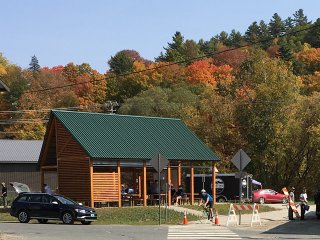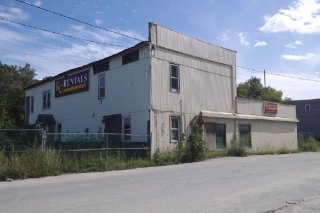R1 Success Story: Three Rivers Trailhead, St. Johnsbury, Vt.

EPA Grant Recipient:
Town of St. Johnsbury
Grant Types:
Assessment and Cleanup
Current Use:
Trailhead
Former Uses:
Blacksmithing, automobile servicing, plumbing & heating, bottling, furniture finishing, and other commercial uses
Download Success Story:
Three Rivers Trailhead St. Johnsbury, Vt. (pdf)
The cleanup of an abandoned 0.21‐acre brownfield in St. Johnsbury has allowed the town to connect to New England's longest rail trail system and bring new life and vitality into the community.
History
In 2012, the town of St. Johnsbury bought the property at 195 Bay St. through a tax sale. The property has a history of commercial and industrial uses that may have contributed to environmental concerns. Originally a place used for "fill" along the Passumpsic River, the property over the last century had been used for blacksmithing, automobile servicing, bottling, plumbing & heating, furniture finishing, and other commercial uses. Thanks to its EPA Brownfields assessment grant, the town of St. Johnsbury was able to use $35,256 in EPA funding to conduct a Phase 2 assessment of the site to determine the nature and extent of contamination. The Vermont Department of Environmental Conservation contributed another $3,000 of its EPA funding to help assess the site. Asbestos‐containing materials were found in the building and low levels of petroleum and other contaminants were detected in the ground.
Once the town was able to acquire the property, they were ready to move ahead with plans to revitalize it as a trailhead for the rail trail. In 2014, the DEC determined that the low‐level contamination in the ground was adequately addressed by keeping it capped and secured with a notice to the land records. However, the dilapidated building remained, and it could not be demolished until the asbestos was removed. In 2019, the Vermont Agency of Commerce and Community Development gave the town $35,000 from its Brownfields revolving loan fund, which paid to remove the asbestos in the summer of 2019 after which the town safely demolished the building. The trailhead, a shelter, and a bike rack were built in 2019.
Lamoille Valley Rail Trail

The Lamoille Valley Rail Trail is an ongoing project in Vermont focused on connecting communities and providing outdoor recreational opportunities across the northern part of the state. The idea has been in the works for about 20 years and 33 miles have been finished so far. The trail recently received state funding and is scheduled to be finished by 2023. Once complete, the 93‐mile trail will connect Vermont towns all the way from St. Johnsbury to Swanton, making it New England's longest rail trail. It is expected to bring in tourism to help rebuild the economy of towns along the route.
Construction to connect the Three Rivers Bike Trail ‐the last 1.5‐mile section of trail leading up to St. Johnsbury ‐to the Lamoille Valley Rail Trail was finished in September 2020, making St. Johnsbury the starting point at the eastern end of the trail. EPA Brownfields funding, including $38,256 for assessing the contamination and $35,000 for cleanup, enabled the town to remove the rundown building and create the new trailhead.
"We are super excited to be connecting downtown St. Johnsbury with the Lamoille Valley Rail Trail. The opening of the downtown trailhead pavilion is phase one of a two‐phase effort to bring outdoor enthusiasts to downtown St. Johnsbury. The trailhead pavilion project was also crucial in dealing with slums and blight located along St. Johnsbury's riverfront corridor; a win‐win for sure!"
Chad Whitehead
Town Manager
The Three Rivers Trailhead Today

The project gives residents of St. Johnsbury access to an exciting statewide outdoor recreation asset and a more walkable community. By cleaning up this brownfield and connecting the community to the Lamoille Valley trail, the town can attract cyclists, hikers, tourists, and naturalists which will in turn help support the local economy.
Since the project began, new businesses have come to the area and old businesses have been able to renovate and recover. For example, a local distillery and a microbrewery have been growing thanks to the trailhead project. The trailhead has also started to foster new business ventures such as a bike rental company, micro food vendors, and hostels that will be aimed at bringing in tourism and business growth to the St. Johnsbury area in the near future. These successes have caused the town to pursue other growth opportunities, including plans for more off‐road sections of the path that lead to the river.
For more information:
Visit the EPA Brownfields website at www.epa.gov/brownfields or contact Frank Gardner at 617 918 1278 or gardner.frank@epa.gov.
EPA 901 F 21 009
October 2021
